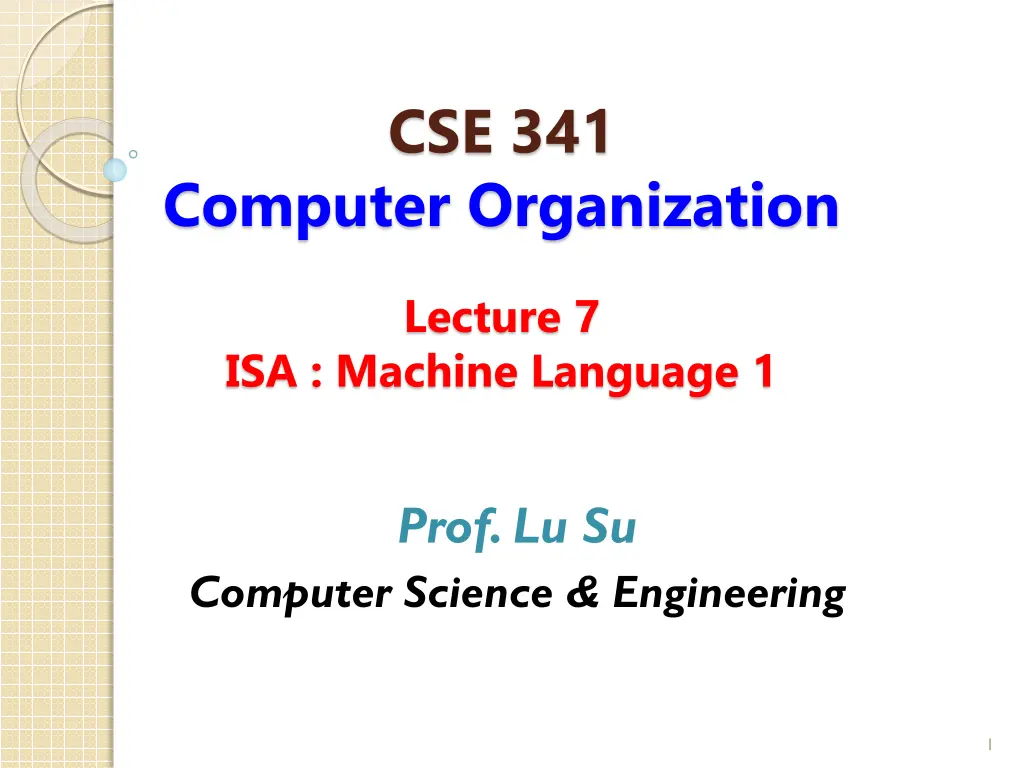
Understanding MIPS Machine Language Concepts
Explore the concepts of machine language and assembly language, the breakdown of main memory, MIPS machine language design, instruction encoding, and the R-type format for register-to-register operations. Learn how instructions are represented as numbers, stored in memory, and decoded by the CPU.
Download Presentation

Please find below an Image/Link to download the presentation.
The content on the website is provided AS IS for your information and personal use only. It may not be sold, licensed, or shared on other websites without obtaining consent from the author. If you encounter any issues during the download, it is possible that the publisher has removed the file from their server.
You are allowed to download the files provided on this website for personal or commercial use, subject to the condition that they are used lawfully. All files are the property of their respective owners.
The content on the website is provided AS IS for your information and personal use only. It may not be sold, licensed, or shared on other websites without obtaining consent from the author.
E N D
Presentation Transcript
CSE 341 Computer Organization Lecture 7 ISA : Machine Language 1 Prof. Lu Su Computer Science & Engineering 1
Todays Content in Big Picture SW Part-I Ch2 Part-II Ch3,4 Part-III Ch1,5,6 ch2 ch1 I/O device Ch6 Ch3,4 Ch5 Computer Organization and Design (5thedition) by Patterson and Hennessy 2
Task 2: From ASM to Machine A=B+C High-level Language(C/Java) Compiler add $t0, $s1, $s2 Assembly language Assembler Machine language 000010001100100100000000100000 HW-level operation 3
ASM vs Machine Language So far we ve been using assembly language, some readability -- Operations (e.g., add) and operands (e.g., $t0). -- Branches/jumps use labels instead of addresses. -- Many pseudo-instructions. Programs must eventually be translated into machine language -- Binary format, stored in memory and decoded by CPU. 4
Stored-Program Concept The words of a computer s language are called instructions, and its vocabulary is called an instruction set. Today s computers are built on two key principles: 1. Instructions are represented as numbers. 2. Programs are stored in memory to be read or written, just like data. 5
MIPS Machine Language MIPS machine language: is designed for easily decode. -- Each instruction has the same 32-bits length -- Only three different instruction formats 7
R-type Format R-type format: design for register-to- register arithmetic/logic instructions, like add, and -- op: operation code (opcode) -- rs, rt: 1stand 2ndsource register -- rd: destination register -- shamt: for shift instruction -- func: used with op to select functions 9
Number for Register Recall that register can be represented by decimal number: eg. $t8 is $24 In MIPS machine language, register name is encoded by 5-bit binary number: eg.11000 represents $t8 10
Example for Add add $t0, $s1, $s2 0 17 18 8 0 32 000000 10001 10010 01000 00000 100000 11
Example for Add 18 s2 17 s1 t0 8 add $t0, $s1, $s2 Register File Memory 12
Review of Memory CS: chip select, enable/disable signal (CS=1/0) ADRS: The address of memory being accessed WR=0, read phase, OUT=data stored in the address (ADRS) WR=1, write phase, data stored in the ADRS is replaced by DATA
Memory in the MIPS Byte-addressable, each data entry is 8-bit Width of address bus is k=32 - totally 232entries - total volume can reach 4GB
Register File A combination of multiple registers -- Contains 2kn-bit Registers --Write=1, D data stored into D address -- No enable signal for read --When supplying the inputs of A address and B address, output appears as A data and B data 2kx n Register file
MIPS Register File 32 x 32 Register file -- Contains 32 32-bit registers -- More register is expensive due to area budget -- Register is for most frequently used data and operation (instruction) -- Memory is for less frequently used and large-size (>32-bit) data.
Example for Sub sub $t0, $s1, $s2 0 17 18 8 0 34 000000 10001 10010 01000 00000 100010 17
Example for And and $t0, $s1, $s2 18
Example for And and $t0, $s1, $s2 0 17 18 8 0 24hex 000000 10001 10010 01000 00000 100100 19
R-type Format for Shift Shift instruction is slightly different -- rs is always 010 -- rt: source register -- rd: destination registe -- shamt: for shift instruction -- func: used with op to select functions 20
Example for Shift sll $t2, $s0, 4 0 0 16 10 4 0hex 000000 00000 10000 01010 00100 000000 21
Example for Shift srl $t2, $s0, 4 22
Example for Shift srl $t2, $s0, 4 0 0 16 10 4 02hex 000000 00000 10000 01010 00100 000010 23
